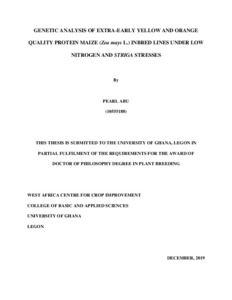| dc.contributor.author | Abu, P. |
| dc.date.accessioned | 2021-02-19T10:04:46Z |
| dc.date.available | 2021-02-19T10:04:46Z |
| dc.date.issued | 2019-12 |
| dc.identifier.citation | Abu, P. (2019). Genetic analysis of extra-early yellow and orange quality protein maize (Zea mays L.) inbread lines under low nitrogen and Striga stresses. Accra, Ghana, University of Ghana. (175 p.). |
| dc.identifier.uri | https://hdl.handle.net/20.500.12478/7058 |
| dc.description.abstract | Low soil nitrogen (low-N) and Striga hermonthica (Del.) are major constrains hampering maize production in sub-Saharan Africa (SSA). Developing extra-early quality protein maize (QPM)-provitamin A hybrids that combine low-N tolerance with Striga resistance is crucial for addressing the food security and undernourishment challenges in SSA. The objectives of this study were to i) assess the genetic diversity among a group of extra-early yellow QPM and orange QPM-provitamin A maize inbred lines, ii) identify low-N tolerant inbred lines, iii) determine the gene action for grain yield and other traits among the inbreds under low-N, Striga, and optimal environments iv) assess the performance and stability of the hybrids under low-N, Striga infestation and optimal conditions, and v) identify markers and candidate genes associated with low-N tolerance among the lines. One hundred and ten extra-early QPM inbred lines were evaluated under low-N to select tolerant lines, and were assayed for tryptophan content. The lines were also genotyped using 2500 single nucleotide polymorphism (SNP) markers. The admixture model-based population structure method and the unweighted pair group method with arithmetic mean (UPGMA) clustering method revealed five clusters among the inbreds based principally on the endosperm colour, pedigree and selection history. Thirty-eight percent of the lines assayed for tryptophan content had levels that met the minimum requirement of 0.07%, indicating the need to introgress tryptophan favourable alleles into the source populations. Four lines, TZEEIORQ 73A, TZEEQI 392, TZEEQI 394 and TZEEQI 408 combined low-N tolerance with acceptable levels of tryptophan. Twenty-four lines with optimum tryptophan content (16 yellow QPM and eight orange QPM-provitamin A) were selected to develop ninety-six single cross hybrids using the North Carolina design II (NCD II). The hybrids were screened under low-N conditions (30 kg ha-1), Striga-infestation and optimal management conditions in Ghana and Nigeria in 2018. Significant general combining ability (GCA) and specific combining ability (SCA) effects were observed for grain yield and most agronomically important traits in the low-N, Striga-infested and optimal management conditions. This suggested that the inheritance of the traits was regulated by additive and non-additive gene action. However, additive gene effects were preponderant over non-additive gene for grain yield and most traits. The contribution of GCA-male and GCA-female effects were comparable for most traits in the different management conditions with the exception of plant height under Striga-infested conditions where significant cytoplasmic effects were observed. TZEEQI 358 exhibited significant and positive male and female GCA effects for grain yield under low-N, Striga infestation and optimal management conditions, therefore it could be used for populations improvement. TZEEIORQ 9A and TZEEQI 409 displayed significant and positive GCA-male and female effects for grain yield under low-N while TZEEIORQ 46 had significant and positive GCA-male and female effects in Striga-infested environments. TZEEQI 358 displayed significant and negative GCA-male and female effects for Striga damage while TZEEIORQ 46 displayed significant and negative GCA-female effects for number of emerged Striga plants. These inbreds could be useful in improving germplasm or populations for Striga resistance and low-N tolerance respectively. TZEEIORQ 58 x TZEEQI 397 which displayed the highest level of grain yield stability across the environments should be broadly tested in multiple environments for commercialization in SSA. Fifteen SNP markers with significant association to grain yield, low nitrogen tolerance index (LNTI), low nitrogen base index (LNBI) under low-N and high nitrogen conditions were identified. These SNPs were located within quantitative trait loci (QTLs) known for low-N tolerance. The markers could be useful for marker-assisted selection to improve the extra-early QPM inbred lines and other populations for low-N tolerance. |
| dc.format.extent | 175 p. |
| dc.language.iso | en |
| dc.publisher | University of Ghana |
| dc.subject | Maize |
| dc.subject | Striga Hermonthica |
| dc.subject | Early Maturation |
| dc.subject | Provitamins |
| dc.subject | Food Security |
| dc.subject | Hybrids |
| dc.subject | Inbred Lines |
| dc.title | Genetic analysis of extra-early yellow and orange quality protein maize (Zea mays L.) inbread lines under low nitrogen and Striga stresses |
| dc.type | Thesis |
| cg.contributor.affiliation | University of Ghana |
| cg.contributor.affiliation | International Institute of Tropical Agriculture |
| cg.coverage.region | Africa |
| cg.coverage.region | West Africa |
| cg.coverage.country | Ghana |
| cg.coverage.country | Nigeria |
| cg.coverage.hub | Headquarters and Western Africa Hub |
| cg.identifier.bibtexciteid | ABU:2019 |
| cg.authorship.types | CGIAR and developing country institute |
| cg.iitasubject | Aflatoxin |
| cg.iitasubject | Agronomy |
| cg.iitasubject | Food Security |
| cg.iitasubject | Maize |
| cg.iitasubject | Plant Breeding |
| cg.iitasubject | Plant Production |
| cg.notes | IITA supervisor: Dr. B. Badu-Apraku |
| cg.publicationplace | Accra, Ghana |
| cg.accessibilitystatus | Limited Access |
| cg.reviewstatus | Peer Review |
| cg.usagerightslicense | Copyrighted; all rights reserved |
| cg.targetaudience | Scientists |
| cg.iitaauthor.identifier | BAFFOUR BADU-APRAKU: 0000-0003-0113-5487 |
| cg.futureupdate.required | No |

